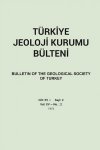
-
2025
-
2024
-
2023
-
2022
-
2021
-
2020
-
2019
-
2018
-
2017
-
2016
-
2015
-
2014
-
2013
-
2012
-
2011
-
2010
-
2009
-
2008
-
2007
-
2006
-
2005
-
2004
-
2003
-
2002
-
2001
-
2000
-
1999
-
1998
-
1997
-
1996
-
1995
-
1994
-
1993
-
1992
-
1991
-
1990
-
1989
-
1988
-
1987
-
1986
-
1985
-
1984
-
1983
-
1982
-
1981
-
1980
-
1979
-
1978
-
1977
-
1976
-
1975
-
1974
-
1973
- 1972
-
1971
-
1970
-
1969
-
1968
-
1966
-
1964
-
1963
-
1961
-
1959
-
1958
-
1955
-
1954
-
1953
-
1952
-
1951
-
1950
-
1949
-
1948
-
1947
Abstract: L`utilisation de la méthode géochronologique Rb-Sr a permisde mesurer un âge moyen de 50 M.A. sur six échantillons de laboratoireprovenant de quatre échantillons de terrain prélevés dans la massif d`Orhaneli (Bursa). Bien que lâge radiometrique coincide avec lâge proposé(Tertiaire) par un certain nombre de géologues de terrain d`autres chercheurs avancent un âge fort différent (Paléozoique).Dans le cadre de ce travail, il n`a pas été possible de savoir si ces 50M.A. correspondent à lâge d`une intrusion (primaire), ou au rajeunissement (secondaire) d`un massif d`âge Paléozoique. Cependant, il est acquis que le massif granodioritque d`Orhaneli a subi, il y a 50 M.A. les effetspeut-être conjugués de lun ou de l`autre de phénomènes géologiques telsque plutonisme, métamorphisme ou tectonique intense. Les travaux deterrains actuellement en cours dans le massif d`Orhaneli se poursuiventdans une optique géochronologique.
Abstract: Im Gebiet des Eğrigöz-Massivs wurden die Mineralfazies derregionalen Metamorphose untersucht und festgestellt, dass dieMetamorphose den Grad der Migmatisation erreichte. Das Auftreten der Indexmineralien Cordierit und Sillimanit in den hochgradig-metamorphen Serien beweisst, dass die regionale Metamorphose einen mittleren Typen zwischen Barrow und Abukumaeinnimmt. Radioaktive Altersbestimmungen aus dem Arbeitsgebiet und Vergleiche mit Angaben aus anderen Teilen des Menderes-Massivs ergaben, dass die hochgradige, bis zu Migmatisation angestiegene Metamorphose postliassich, also frühalpidischstattgefunden hat, dass aber das anatektische Eğrigöz-Massiv indie Deckschichten erst nach der Oberkreide eingedrungen ist.Die röntgenographischen Messungen der durch schwere Lösungen angereicherten K-Feldspäte aus der höchstgradig regionalmetamorphen Zone zeigten, dass sie auf der von 1 bis 10 eingeteilten Hoch Sanidin-Maximum Mikroklin Tabelle der 4. Reihe undsomit einem Strukturver-hältnis Or60oMi40 entsprechen. Andererseits steigt der Albitgehalt im K-Feldspat bis zu 20 % an. Setztman die ermittelten Werte in Diagramme ein, die aus Laborversuchen gewonnen wurden, so erhält man eine Transformationstemperatur von 500-550°C. Dieser Wert liegt aber weit unter derMigmatisationstemperatur von 680-700°C, die für eine hochgradige Metamorphose notwendig ist.Es ist daher möglich, folgende Überlegungen als AlternativVorschläge anzustellen :
1. Seit der letzten Metamorphose steigt derAl-Si-Ordnungsgrad der K-Feldspäte, d.h. ihre Triklinität erhöht sich.
2. Bei der letzten Aufheizung erreichte die Temperatur im Gebiet um 500-550°C.Im Anbetracht der geologischen Verhältnisse scheint die zweite Überlegung einen höheren Grad der Wahrscheinlichheit zu haben. Es ist sehr Wahrscheinlich, dass bei dem Emporsteigen derMassive an der Kreide-Tertiärgrenze die Temperatur im Untersuchungsgebiet nur bis 500-550°C anstieg und die an den K-Feldspäten festgestellte Erhöhung der Al-Si-Ordnung (Orthoklas-Mikrolin-Transformation) zu dieser Zeit stattgefunden hat.
Abstract: It is apparent from works of art that marbles and other coloured stones had a special place in the architecture of the different civilizations throughout Turkish history.In Turkey, past and present, approximately 90 % of the stones that canbe scientifically described as marbles, come from Afyon and the Island ofMarmara.In view of this fact, a detailed researah project has been initiated bythe Applied Geology Department of the İ.T.Ü. Mining Faculty to investigatethe geological and physico - mechanical properties of these marbles.The physico-mechanical and technological properties of the abovementioned marbles have been evaluated both in the field and the laboratory. Also, apart from criteria such as colour, and where it is to be used,in the classification of marbles other functional and numerical items likecrystal dimensions, degree of weathering and mechanical anisotropyhave been proposed. At the moment further investigation related to theclassification of other marbles and coloured stones with regard to the numerical criteria used for Afyon and Marmara marbles is being carried out.
Abstract: The effect of weathering on the physical and mechanical properties of marbles has been studied. Prior to the experiments fresh marble specimens were subjected to laboratory weathering. Water absorbtioncapacity of the weathered and fresh specimens was determined as weight percent (Wn, Wo) and a relationship has been established with thedegree of weathering (Dw ) as;
Dw = WnWo / Wo
It is observed that with the increase of (Dw) water absorbtion capacity,porosity and unit volume increases but unit weight and compressionalstrength decreases.
Abstract: During the Upper Cretaceous-Lower Tertiary time a continuous (3200 m) sedimentation, mainly consisting of submarine slumps,olistostromes and turbidity currents, was taking place in the western halfof the area. Meanwhile, in the eastern half, a granit complex plutonic intrusion was emplaced (Early Paleocene) in a formation, dominantly consisting of basic submarine lavas and tuffites. Uplift, erosion and subsidence of the eroded surface was followed by a marine transgression nearthe closing of Paleocene times. Following the deposition of neritic andpartly littoral sediments (700 m), towards the end of Eocene (post Lutetian) a regression developed over the whole area, causing the depositionof mainly red colored rudite, arenite and lutite, as well as lagoonal whitelimestone and gypsum.Horizontal Neogene clastics rest with an angular unconformity onthe folded, uplifted and eroded sediments of Late Cretaceous-EarlyTertiary age.
Abstract: Systematic study of new species of the genera Fabularia andKathina with associated Foraminifera in Paleocene of Kars Region (NETURKEY), are given.

 TMMOB
TMMOB